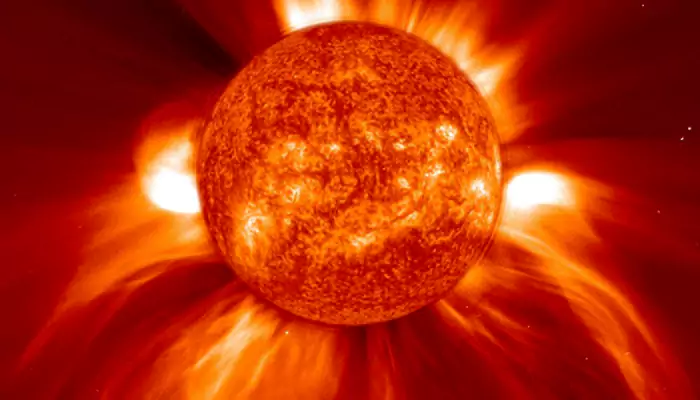NASA to Launch APEP Mission on April 8: Here's What Scientists Have Learned from Total Solar Eclipses So Far!
- Admin
- 1 year ago
- 4 minutes read

NASA's upcoming mission, the Atmospheric Perturbations around Eclipse Path (APEP), is set to launch three sounding rockets into the moon's shadow on April 8, coinciding with the Total Solar Eclipse. This ambitious venture aims to investigate the enigmatic effects of sudden sunlight reduction on Earth's upper atmosphere, specifically the ionosphere. Departing from NASA's Wallops Flight Facility in Virginia, these rockets will conduct a sophisticated experiment to analyze the disturbances caused when the Moon obscures the Sun. This initiative promises to unveil invaluable insights into the intricate interaction between celestial bodies and our planet's atmospheric dynamics.
Throughout history, scientists have seized the remarkable occurrence of a total solar eclipse to uncover fresh insights about the world, unattainable through conventional means. Solar eclipses have served as natural laboratories, yielding discoveries ranging from the identification of one of the universe's most abundant elements to revelations about the fabric of space and time.
The Nearest Star
The sun, Earth's nearest star, poses a challenge for observation due to its intense brightness, masking the faint corona, visible only during total solar eclipses when the moon completely blocks the sun's face. Jay Pasachoff, an astronomer at Williams College, likens understanding the sun without seeing its corona to learning about Earth without its atmosphere. Recorded observations of the corona date back to 968 AD, during a total eclipse witnessed by Byzantine historian Leo Diaconus in Constantinople.
Solar eclipses, occurring roughly every 11 years, provided early insights into the sun's coronal activity before space-age satellites. NASA notes eclipses' role in studying coronal mass ejections (CMEs), first observed during the 1860 eclipse. Solar prominences, massive accumulations of cooler gas anchored by the sun's magnetic field, were also discovered during eclipses, as detailed in historical records. Understanding the sun's magnetic fields and corona dynamics aids in predicting space weather's impact on Earth and space missions.
Hot Hot Hydrogen
In 1868, French scientist Jules Janssen journeyed to India, to observe a solar eclipse. Examining the sun's chromosphere, he discovered "helium," named after the Greek word for sun, "helios." In 1879, Charles Augustus Young and William Harkness identified "coronium" during an eclipse, later revealed as high-temperature iron. This puzzled scientists, as the corona is hotter than the sun's surface. In 1970, NASA's 32 suborbital rockets uncovered hydrogen atoms surviving in the corona's extreme heat. Artificial eclipses are created using coronagraphs, but natural eclipses offer unparalleled insights. Despite advancements, technical limitations persist, failing to match nature's spectacle.

Home Planet
Eclipses offer insights beyond the sun, revealing Earth's mysteries. Nordgren, a University of Redlands professor, notes ancient eclipses unveiled the moon's size and Earth's spherical nature. Aristarchus used lunar eclipses to gauge the moon's size, then estimated the sun's dimensions through solar eclipses. Records surrounding eclipses aid historical dating; Herodotus mentioned one pre-dating Persia's invasion of Greece. Astronomer John Russell Hind narrowed its occurrence to Feb. 17, 478 BCE. Halley, during the 1715 eclipse, initiated citizen science, urging public participation in recording eclipse durations. This collective effort enhanced lunar orbit measurements and eclipse predictions.
Probing Earth's Atmosphere
Solar eclipses offer scientists a unique opportunity to study Earth's atmosphere. During totality, when the sun is fully obscured, ionization processes cease, affecting radio wave propagation. In 1999, a project led by Bamford utilized radio observations during a total eclipse over the UK. Normally absorbed during the day, radio waves can bounce off both lower and upper ionospheric layers at night, enabling longer-distance transmission. The eclipse mimics nighttime conditions, causing radio signals to propagate further. This phenomenon, observed through listener reports and amateur radio measurements, revealed variations in signal reception across regions, indicating a "skip-distance effect." Such experiments aid in understanding ionospheric behavior and optimizing radio broadcast efficiency. Despite the potential for cloudy skies, radio observations remain unaffected, making them accessible to diverse participants, including the visually impaired. As solar eclipses continue to intrigue researchers, collaborative efforts between amateur radio enthusiasts and scientists promise further insights into atmospheric dynamics.
Other Worlds
Solar eclipses offer insights into planetary dynamics. During the Aug. 21, 2017 eclipse, Mercury and Venus will be visible, revealing opportunities for scientific observation. Historically, astronomers sought Vulcan, a theorized planet between Mercury and the sun, during eclipses in the 19th century. However, Einstein's theory of general relativity in 1915 debunked Vulcan's existence, attributing Mercury's orbit anomalies to spacetime curvature. In 1919, Eddington's expedition to Africa provided empirical evidence, demonstrating light bending around massive bodies during an eclipse, confirming Einstein's predictions. Eclipses remain pivotal in understanding both celestial mechanics and the universe's mysteries.
While a solar eclipse is a rare and breathtaking event for many, it's evident that these occurrences also unveil significant insights into the cosmos.












